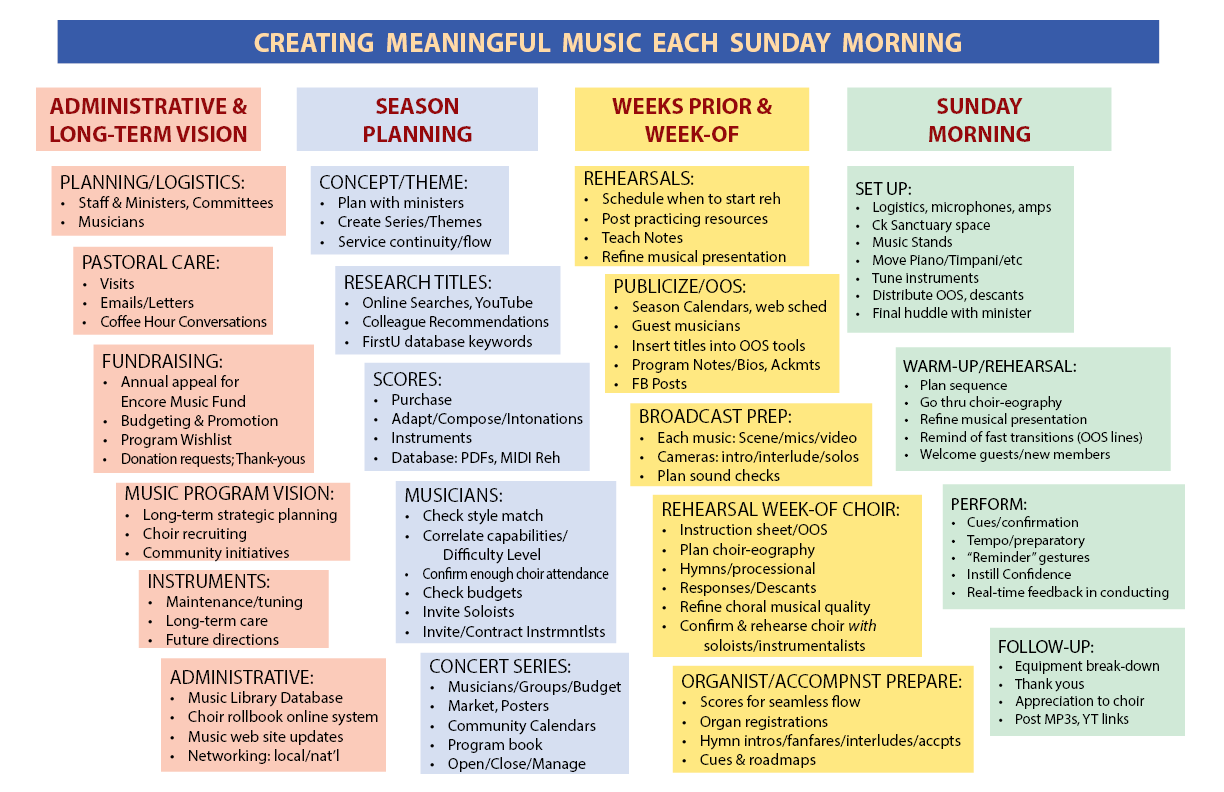MUSICAL ANATOMY OF A CONCERT/SERVICE
What goes on behind the scenes to deliver a quality performance (PDF of below graphic)

Many people do not realize the efforts and preparations needed “behind the scenes” to bring forth quality music performances for our services and concerts. Below is a brief summary to help convey the time and energies devoted to presenting a rewarding musical experience for all.
- Planning – Calendar coordination, topic integration, instrumentation
- Repertoire Selection – appropriate difficulty level, instrumentation & scores readily available, enough voices to do the piece justice, works with service theme, interesting/quality/worthwhile music, adapt existing scores where copyright permits
- Budgeting – ensure that our efforts and expenditures fall within the resources available, and look for creative funding possibilities and generous angels
- Score Purchase – budget or donation available, still published/available
- Locate/Rent/Mail scores to instrumentalists & absentee choristers
- Score Arrangement/Preparation – almost always some instrumentation arranging (music writing) is needed to adapt/enhance existing scores to suit our specific set of performers
- Musician Contracting – find and hire quality instrumentalists who are available. Sort and mail scores. Replace last-minute absentees.
- Scheduling – reserve the facilities (for rehearsal and performance set-up) and lectionary “slots”; manage the temperature and environmental aspects of the instruments’ performance space
- Instrument Tuning – see that pipe organ and piano/harpsichord are tuned
- Publicity – collect info/bios/headshots/illustrations, write Press Release & various calendar/ad copy, distribute to a large list of media outlets/calendar resources, solicit media interviews/articles
- Program Notes - Research composer, music, style, instrumentation, performance practice, interpretation, etc. and boil down to make an interesting editorial explanation for your audience.
- Rehearsals & Coordination – plan and invite personnel, make sure facilities/equipment/logistics are in place, set out music stands/chairs/etc, time-schedule/budget the rehearsal for optimal efficiency to attain quality performance
- Practice - Learn the score: whether conducting and/or accompanying, know the music rock solid such that if anything strays during performance, you can know it instantly and improvise a get-well strategy to avoid a train wreck. Identify and practice "transistions" - places in the music where it slows down, changes tempo, etc.
- Printed Programs: Collect titles/performers and program notes. Proofread for accuracy and completeness. Include next-events calendar & sign-up for mailing lists.
- Logistics: House Logistics, Performance Logistics, Risers, Stands/Chairs– assemble text; solicit house manager/ushers, etc.
- Reception or choir snacks (if applicable) – solicit volunteers to bring food/drinks, arrange for servers, clean-up
- Sell Choir CDs – set up table, encourage sales, manage money collected
- Instrument/Equipment “Breakdown” – take down music stands/chairs/risers, put away keyboards/instruments
- Notes of Appreciation – Express thanks to those involved, including newsletter paragraph.

